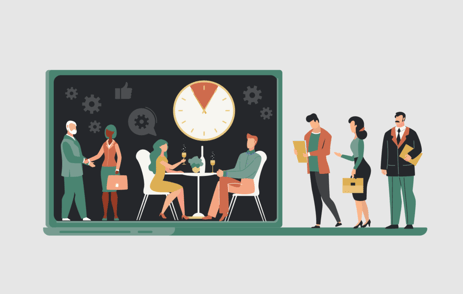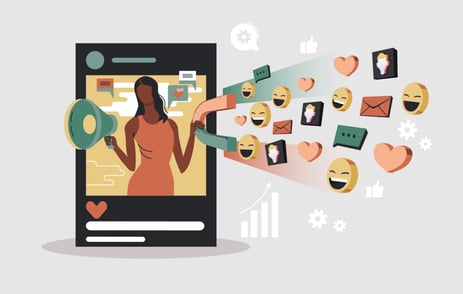You’re more than 18 months into a pandemic you thought would be resolved in two weeks. To say the pandemic has disrupted your work and turned your personal life upside down is an understatement.
If you wish things could magically go back to “normal,” you’re in good company. But the truth is “normal” wasn't working for you and your members.
So how do we avoid slipping into old norms that weren’t working for us?
How do we use this as an opportunity to create a way of living and working that works better for everyone whether you’re working virtually or in-person or both?
Here are five tips to help you make a smooth transition to the post-pandemic workplace.
Tip 1: Create and Communicate Your Return To Office & Hybrid Workplace Plan
A recent McKinsey study on workplace burnout found the one thing that burned-out employees have in common —their leaders lack a hybrid plan or have not communicated their plan.
47% of people in the workplace feel a lack of clear vision about work in the post-pandemic world is a cause for concern or anxiety. This anxiety coupled with prolonged uncertainty takes a toll on you mentally, emotionally and physically. The result is a domino effect that decreases work performance, reduces job satisfaction and negatively affects interpersonal relationships with colleagues, members and other stakeholders.
Create your plan with input from staff and members and be sure to communicate it. This is probably the single most important thing you can do to reduce stress and burnout right now.
You’re plan doesn’t have to be perfect. It’s doesn’t need to 100-page document no one will ever read. Start with one to two pages that speak to the basics (who, what, when, where, why, how, etc.) and iterate from there.
And if you don’t have a plan, be upfront about where you are in the process. This helps reduce anxiety and uncertainty similar to having a detailed plan with specifics.
Tip 2: Understand Hybrid is Here to Stay
The hybrid workplace model isn’t new. The idea of people working in different locations or a mix of people working in-person at the office and others working remotely from home or other locations has been around for many years before the pandemic.
For example, my colleague Beth Kanter has written about nonprofits with affiliate offices that have been working this way for years. In her book Happy Healthy Nonprofit, she describes flex place and time as a perk many nonprofits were offering to employees. They could work at home part-time as long as they were getting their work done.
Pre-pandemic, hybrid models consisted of a small number of remote employees while a core group worked in-person in the office. Post-pandemic, it is likely that more people will be remote at one time and the office becomes one of many nodes, shifting away from a top-down model to a distributed model. This means productivity and performance indicators will change from seat-time to deliverables and outcomes.
Some of us will continue to work remotely (all or some of the time) while others will work in person. Creating a thriving post-pandemic workplace culture requires recognizing and adapting to this new dynamic.
Tip 3: Make Inclusion a Key Pillar of Your Hybrid Workplace
In the hybrid workplace, digital inclusion is paramount. This means ensuring everyone (staff and members) has the capacity and access to the tools and information needed to fully contribute to advancing the missing of your work.
For example, in meetings, this means everyone is able to fully participate regardless of location or time zone. This requires teams to be flexible, intentional and diligent about bridging gaps (e.g. skills, platform, time zone, etc.) not as an afterthought, but as part of the process for any type of collaboration, meeting or engagement.
This also means being mindful of how the culture and values of your association translate to the remote and hybrid context. Creating a Zoom account and securing a high-speed internet connection is the easy part. The more challenging part requires us to think through how we execute activities such as facilitating authentic social bonds and connections when rituals we relied on for in-person gatherings may not be applicable.
Tip 4: Adopt a Digital-First Mindset
Adopting a digital-first mindset doesn’t mean simply uploading a recording of a call to the cloud as an afterthought. It’s also more than having the latest video conferencing software and a high-speed internet connection. It’s a way of thinking and working that acknowledges the integral role digital technology plays in how we live and work.
This way of thinking and working includes things such as digitally-accessible meeting agendas for those participating in meetings remotely and collaborative note-taking using tools such as cloud-based document storage.
It also means recognizing that technology allows us to be connected 24/7 and being able to proactively set boundaries that support a healthy tech-work-life balance and avoid challenges such as Zoom fatigue from too many video meetings.
Creating your Zoom number and establishing your rules of engagement as I discussed in my last post are great places to start.
Tip 5: Be Flexible
Creating a healthy workplace culture (especially in the post-pandemic workplace) is an ongoing process that doesn’t happen overnight.
It's an ongoing process that’s not one-size-fits-all. What works for your team and members may not work for another association and vice versa.
Next Steps
Yes, it has been hard. And hybrid poses another change in the way we work. In times of massive change and uncertainty, it may be hard to see beyond the initial anxiety. But know this doesn't change your mission. In fact, it's in times like these that you are called to lean more fully into our missions because your members need you more than ever.
As you settle into the "new normal," remember to control what can control and release the rest. One of the ways we can take control is to create a plan and communicate it using the tips outlined above as your starting point.
Not sure where to start? Or feeling overwhelmed? Start with just ONE thing and build from there.
Which step are you starting with? Write a comment below. I’d love to hear from you.
Tags:
COVID-19
November 12, 2021


